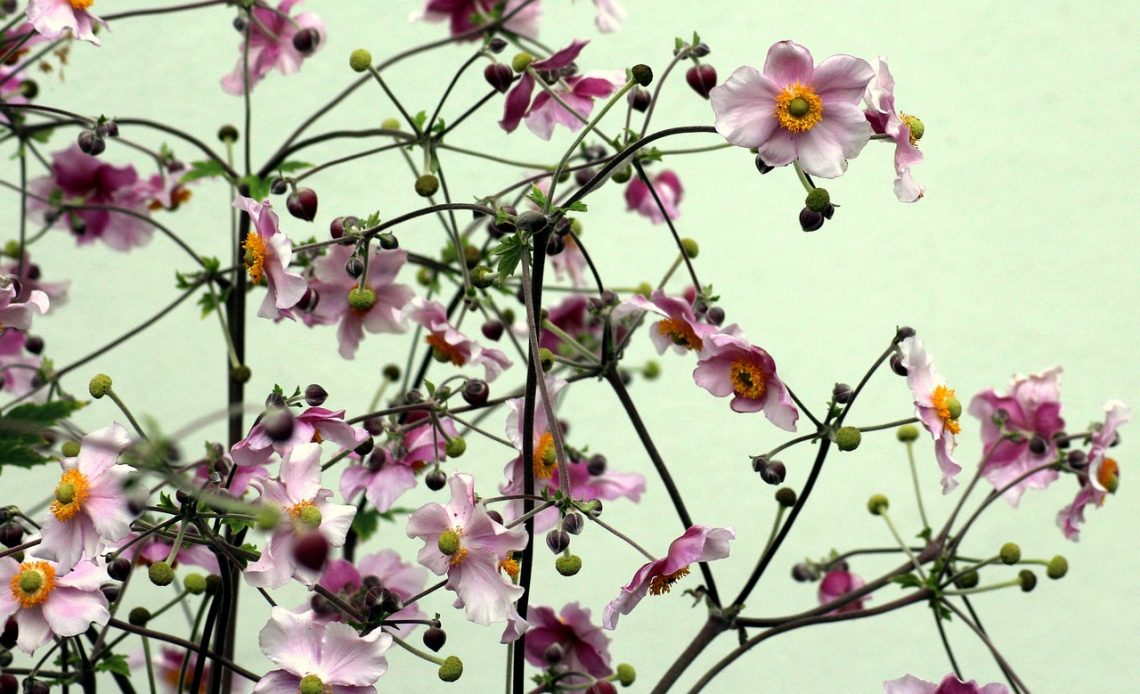
The anemone flower holds a rich tapestry of meanings and symbolism that have captivated cultures throughout history. This article delves into the diverse interpretations and significance of the anemone, encompassing its cultural, historical, artistic, and literary associations.
Culturally, the anemone flower has played a significant role in various societies. It has been revered as a symbol of love, beauty, and fragility, and is often used in traditions and celebrations. In some cultures, the anemone is believed to bring good luck and protection against evil spirits. Its vibrant colors and delicate petals make it a popular choice for floral arrangements and decorations during special occasions.
Historically, the anemone flower has left an indelible mark in ancient civilizations. It has been depicted in myths, legends, and folklore, often representing different aspects such as rebirth, death, and transformation. The flower’s ephemeral nature and ability to bloom in harsh conditions have made it a powerful symbol of resilience and survival.
Anemones have also found their place in the world of art and literature. Throughout history, artists have captured the beauty and symbolism of the anemone in various forms. Paintings, sculptures, and decorative arts have showcased the flower’s elegance and allure, evoking emotions and narratives. In literature, the anemone has been a muse for poets, novelists, and playwrights, symbolizing love, mortality, and the transient nature of life.
Religious symbolism surrounding the anemone flower is also prevalent in different faiths and belief systems. It is often associated with deities, rituals, and spiritual practices. In some cultures, the anemone is seen as a sacred flower that holds divine connections and is used in religious ceremonies and offerings.
In modern culture, the anemone flower continues to inspire and be interpreted in various ways. Its beauty and symbolism have found their way into fashion, jewelry, and home decor. The anemone’s vibrant petals and intricate designs are often incorporated into stylish accessories and stunning artistic creations, allowing individuals to carry its meanings and symbolism with them in their everyday lives.
In conclusion, the anemone flower is a captivating subject that carries a multitude of meanings and symbolism. Its cultural significance, historical references, interpretations in art and literature, and religious symbolism all contribute to its enduring allure. Whether admired for its delicate beauty or revered for its deeper symbolic meanings, the anemone continues to captivate and inspire individuals across cultures and generations.
Cultural Significance
The anemone flower holds immense cultural significance in various societies across the world. It is revered and used in numerous traditions and celebrations, symbolizing different meanings and emotions. In Greek mythology, the anemone is associated with the story of Adonis and Aphrodite, representing love and rebirth. In Chinese culture, the anemone is considered a symbol of luck and protection against evil spirits. In Japan, it is associated with death and used in funeral ceremonies. Additionally, the anemone flower is often used in weddings and other joyous occasions, representing anticipation and excitement for the future.
Historical References
Historical references to the anemone flower can be traced back to ancient civilizations, where it held significant meaning and symbolism. In Greek mythology, the anemone was associated with the goddess Venus and was believed to have sprung from her tears as she mourned the death of Adonis. It was also believed to have healing properties and was used in various medicinal practices.
In ancient Egypt, the anemone flower was associated with death and was often depicted in funerary art and tomb paintings. It was believed to symbolize the journey of the soul in the afterlife. Similarly, in ancient Persia, the anemone was seen as a symbol of death and was often planted near graves.
In folklore and legends, the anemone flower has been associated with various stories and beliefs. In some cultures, it is believed that the petals of the anemone close up when bad weather is approaching, serving as a warning sign. In other cultures, it is believed that the anemone brings luck and protection against evil spirits.
The anemone flower’s historical references and depictions in myths, legends, and folklore highlight its enduring significance and symbolism throughout different cultures and time periods.
Anemone in Art
The anemone flower has been a popular subject in various forms of art throughout history. Artists have been captivated by its delicate beauty and vibrant colors, using it as a symbol of love, beauty, and fragility. In paintings, the anemone is often depicted in still life compositions, showcasing its intricate petals and graceful stems. Sculptors have also been inspired by the anemone, creating intricate sculptures that capture its elegance and ethereal quality.
Decorative arts have also incorporated the anemone flower in various forms. From intricate porcelain vases adorned with anemone motifs to delicate tapestries depicting blooming anemones, the flower has been a recurring theme in decorative art throughout different periods. The anemone’s vibrant colors and delicate form make it a popular choice for artists seeking to evoke a sense of beauty and grace in their work.
Anemone in Literature
Anemone in Literature
The anemone flower has long been a symbol of various emotions and concepts in literature. In poems, novels, and plays, it is often associated with love, beauty, fragility, and mortality.
In love poems, the anemone is frequently used as a metaphor for the delicate and fleeting nature of romantic relationships. Its delicate petals and ephemeral beauty evoke the fragility and transience of love. Poets often use the anemone to express the intensity and vulnerability of their emotions.
Furthermore, the anemone is often used to symbolize beauty in literature. Its vibrant colors and graceful form make it a powerful symbol of aesthetic appeal. Writers use the anemone to describe the beauty of landscapes, people, and objects, emphasizing their allure and charm.
Additionally, the anemone is frequently associated with fragility and vulnerability. Its delicate petals and slender stems make it susceptible to damage and easily affected by external forces. In literature, the anemone is used to represent the vulnerability of individuals and their susceptibility to emotional pain and hardships.
Finally, the anemone is also connected to mortality in literary works. Its short lifespan and tendency to wither quickly serve as a reminder of the transient nature of life and the inevitability of death. Writers use the anemone to explore themes of mortality, impermanence, and the passage of time.
Overall, the anemone flower holds significant symbolism in literature, representing love, beauty, fragility, and mortality. Its presence in poems, novels, and plays adds depth and meaning to the themes and emotions explored by writers.
Anemone in Religious Symbolism
The anemone flower holds significant religious symbolism in various faiths and belief systems. Its connections to deities, rituals, and spiritual practices make it a revered symbol in different cultures.
In Greek mythology, the anemone is associated with the goddess Aphrodite, the goddess of love and beauty. According to the myth, the flower sprouted from the tears of Aphrodite as she mourned the death of her lover, Adonis. This connection to love and beauty has made the anemone a popular flower in weddings and romantic celebrations.
In Christianity, the anemone is often associated with the crucifixion of Jesus Christ. It is believed that the red petals of the flower represent the blood of Christ, while the black center symbolizes his crown of thorns. The anemone is sometimes referred to as the “crown of thorns flower” in this context.
In Japanese culture, the anemone is considered a symbol of luck and protection against evil spirits. It is often used in religious ceremonies and festivals to bring good fortune and ward off negative energies.
Overall, the anemone flower’s religious symbolism varies across different faiths and belief systems, but it consistently represents important aspects such as love, beauty, sacrifice, and spiritual protection.
Interpretations in Modern Culture
The anemone flower has not only maintained its cultural and historical significance but has also found its place in modern culture. Its unique beauty and symbolism have made it a popular choice in various artistic and decorative forms.
In the world of fashion, the anemone flower has become a source of inspiration for designers. Its delicate petals and vibrant colors are often incorporated into clothing designs, adding a touch of elegance and femininity. Jewelry designers also draw inspiration from the anemone flower, creating stunning pieces that capture its essence.
Moreover, the anemone flower has made its way into home decor. Its graceful presence is often depicted in paintings, prints, and decorative items, bringing a sense of natural beauty and tranquility to living spaces.
Whether it is through fashion, jewelry, or home decor, the anemone flower continues to be interpreted and celebrated in modern culture. Its timeless appeal and symbolic meaning make it a captivating choice for those seeking to add a touch of beauty and significance to their lives.
Frequently Asked Questions
- What is the cultural significance of the anemone flower?
The anemone flower holds cultural significance in various societies. It is often associated with different meanings such as love, protection, and luck. In some cultures, it is used in traditional ceremonies and celebrations, symbolizing purity and spiritual enlightenment.
- Are there any historical references to the anemone flower?
Absolutely! The anemone flower has been mentioned in ancient civilizations, myths, legends, and folklore. It has been depicted as a symbol of beauty, fragility, and transformation. Its presence in historical narratives showcases its enduring allure and timeless appeal.
- How is the anemone flower represented in art?
The anemone flower has been a muse for artists throughout history. It has been portrayed in various art forms, including paintings, sculptures, and decorative arts. Artists have captured its delicate petals, vibrant colors, and ethereal beauty, often using it as a symbol of fleeting moments and the ephemeral nature of life.
- What is the symbolism of the anemone flower in literature?
In literature, the anemone flower symbolizes different concepts such as love, beauty, fragility, and mortality. It has been featured in poems, novels, and plays, evoking emotions and exploring themes of transience and the delicate balance between life and death.
- Does the anemone flower hold any religious symbolism?
Yes, the anemone flower carries religious symbolism in various faiths and belief systems. It is often associated with deities, rituals, and spiritual practices. Its presence in religious contexts signifies purity, enlightenment, and divine blessings.
- How is the anemone flower interpreted in modern culture?
The anemone flower continues to inspire and be interpreted in modern culture. It can be seen in fashion trends, jewelry designs, and home decor. Its timeless beauty and symbolism make it a beloved choice for adding a touch of elegance and grace to contemporary aesthetics.

